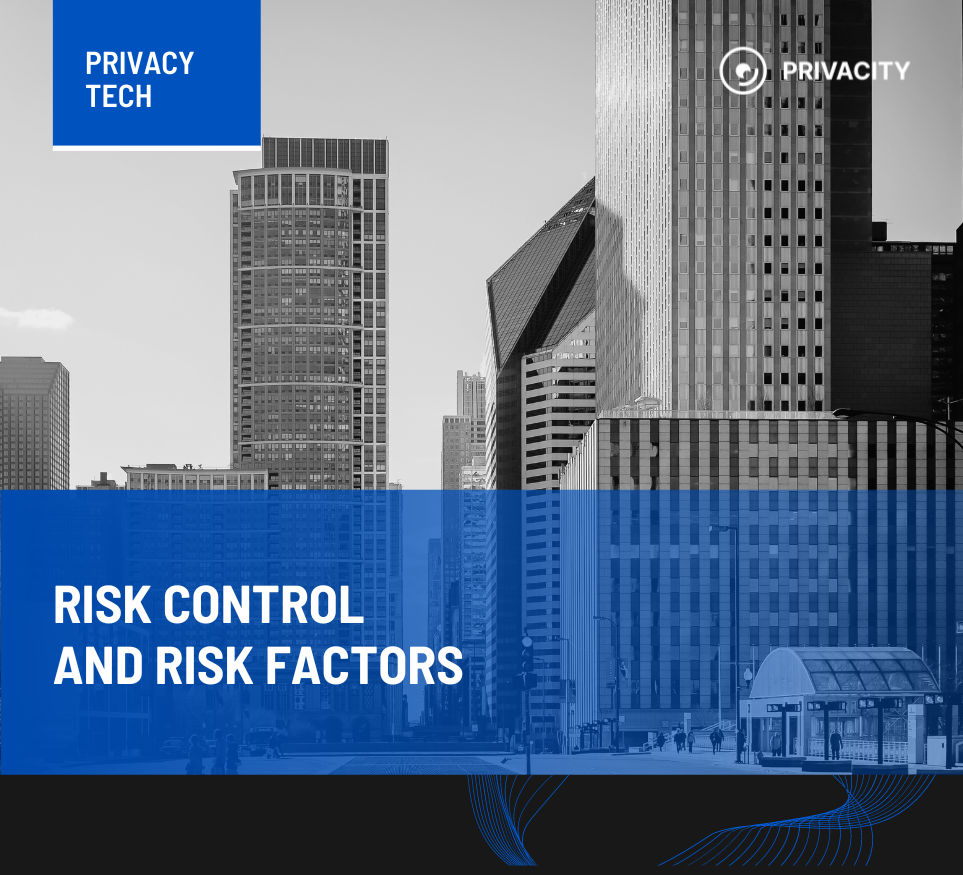Risk Control & Risk Factors in Cybersecurity
In today’s rapidly evolving digital landscape, ensuring information security is paramount for organizations and governments worldwide. Significant challenges arise from countless possible negative events, which threaten overall system security, data integrity, and confidentiality. These events, ranging from accidental data leaks to massive dedicated cyber-attacks, can result in severe consequences not just for data processors, but for system users and occasionally third parties.
The key to managing negative events is risk control. Risk control mechanisms are essential for mitigating the likelihood and impact of negative events by identifying potential harm, assessing probabilities, and implementing appropriate countermeasures. Unfortunately, negative events come in numerous forms and most of them can’t be fully prevented.
So, from a risk control perspective, the focus lies on two aspects:
→ Probability of occurrence: While some events, like equipment failure, can be predicted with reasonable certainty based on the current state, applied load, and manufacturer’s support period, others, such as technological disasters or climate anomalies, are almost unpredictable in the long term.
→ Potential damage that can be caused: The level of potential harm from negative events is crucial for developing effective mitigation strategies. For instance, the loss of a corporate laptop may lead to unauthorized access to sensitive files, highlighting the need for robust security measures like the implementation of data access, media encryption, and data reservation policies.
By applying those two factors to various scenarios, it’s possible to develop a systematic approach to risk control. For example, organizations can create tailored plans to address various types of negative events. These plans can be specialized or generalized, aimed to reduce current risks or serve as guidelines for future developments. Most possible and risky scenarios must include specific and effective algorithms for a quick response. Algorithms for uncommon events like natural disasters can be represented by basic rules that will cover principles, precautions, and key actions.

Algorithms are developed based on known risk factors and mechanisms, but those circumstances can evolve to the point when the initial version won’t be effective enough. Therefore, risk control algorithms must constantly adapt to new internal and external factors, ensuring continued effectiveness.
Such factors may include system upgrades, increased workload, or changes in functionality, while external factors encompass advancements in technology, emerging threats like zero-day vulnerabilities, and the frequency of external attacks. In an ideal world, companies have enough time, specialists, and finance to provide constant threat detection and precautions deployment for all old and new kinds of negative events. However, in reality, risk control algorithms have to be dynamic, prioritize key data categories, and strike a balance between resource consumption and overall system effectiveness.
Risk control strategies and implementation
Adopting a systematic approach to risk control and implementing proactive measures, organizations can enhance their information security posture, mitigate the impact of negative events, and safeguard sensitive data from unauthorized access or disclosure. Effective risk control is essential for maintaining trust with customers, partners, and stakeholders while ensuring compliance with regulatory requirements and industry standards.
Effective risk control strategies require a comprehensive approach that addresses potential threats, evaluates their impact, and implements appropriate countermeasures. Organizations must adopt proactive measures to minimize the likelihood of negative events and be able to mitigate their consequences effectively if such events occur. The basic risk control strategy must include three key segments:
- Risk assessment and monitoring
- Risk mitigation and countermeasures
- Regulations compliance and planning
→ Risk Assessment and Monitoring start with the identification of potential threats and vulnerabilities within and around the organization’s infrastructure. This process involves conducting risk assessments, vulnerability scans, and gap analyses to pinpoint areas of weakness. Once risks are identified, they must be assessed to determine their potential impact and likelihood of occurrence.
Methodologies, such as qualitative and quantitative risk analysis, can help organizations prioritize risks based on their severity and provide crucial data for the development of mitigation strategies. Also, by identifying risks early on, organizations can make informed decisions about resource allocation and risk treatment options while developing its infrastructure around known vulnerabilities which will increase overall resistance to negative events.
Additionally, as conditions are dynamic and can change drastically over time, organizations must regularly assess the effectiveness of their risk control measures, identify emerging threats, and adjust their strategies accordingly. By maintaining vigilance and adaptability, organizations can stay ahead of evolving risks and ensure the resilience of their information security posture.
→ Risk Mitigation and Countermeasures cover most actions aimed at reducing the occurrence chances of negative events and their impact on a company. Mitigation strategies may include implementing security controls, enhancing employee training programs, or investing in cybersecurity technologies. The goal is to minimize the risk to an acceptable level while balancing cost and effectiveness. Despite best efforts to prevent negative events, incidents may still occur. Therefore, organizations must have robust incident response and recovery plans in place to minimize the impact of security breaches or other disruptions. Incident response plans outline procedures for detecting, responding to, and recovering from security incidents, while also mitigating damage and restoring normal operations as quickly as possible.
→ Planning and Regulations Compliance cover general company goals and legislative requirements’ influence on Risk Control. Risk Control is not a one-time effort but an ongoing commitment to improvement.
Organizations must regularly evaluate their risk control strategies, learn from past experiences, and adapt to changing threats, business environments, and legislation. Continuous improvement enables organizations to strengthen their resilience and maintain effective risk management practices over time. Also, it should be considered that through the course of a company’s entrepreneurial activity, new products, services, and other alterations to the initial business model can be introduced. So, the risk control strategy may not be effective enough for the new infrastructure.

As for regulations, compliance with regulatory requirements, such as GDPR, is a critical aspect of risk control. Organizations must ensure that their risk management practices align with relevant regulations and standards, incorporating privacy-by-design principles and data protection measures into their operations. By maintaining compliance, organizations can mitigate legal and reputational risks associated with non-compliance.
Understanding the data lifecycle
The data lifecycle encompasses the journey of information from creation to destruction. In the most common scope, it covers the data existence period in one exact system or company. At its core, the data lifecycle covers 5 stages:
- Collection
- Processing
- Retention
- Disclosure
- Destruction
Effective data lifecycle management is crucial for ensuring the security, integrity, and privacy of information throughout its entire lifespan. From creation to disposal, data must be managed in accordance with best practices and regulatory requirements to mitigate risks and protect sensitive information. Here’s a closer look at the stages of the data lifecycle and key considerations for information security:
→ Data Collection – the beginning of the data lifecycle, whether it’s generated by individuals, collected from various sources, or produced by organization. For example, while interacting with web applications, users can provide different sorts of information to get access to the service.
At this stage, organizations must implement measures to ensure the accuracy, completeness, and quality of data, as well as establish controls to prevent unauthorized data creation.
→ Data Processing – once collected, data undergoes processing, involving calculations and manipulations to achieve the intended objectives.
During this stage, organizations must enforce access controls, authentication mechanisms, and encryption protocols to safeguard data from unauthorized access, modification, or disclosure. Additionally, data usage should comply with privacy regulations and organizational policies to protect individual rights and prevent misuse.
→ Data Retention – after processing, data enters the retention phase, where it is stored for future use. Data retention policies dictate the duration and conditions under which data can be kept, balancing the need for access with privacy and security concerns.
Data storage involves maintaining information in secure repositories, whether on-premises or in the cloud, to ensure availability, durability, and resilience. Organizations must implement robust storage solutions, encryption technologies, and access controls to protect data from loss, theft, or corruption. Furthermore, data retention policies should define the appropriate retention periods for different types of data based on legal, operational, and business requirements.
→ Data Disclosure involves the exchange of information with external parties, such as business partners or external service providers. Organizations must secure data during transmission using encryption protocols, secure channels, and authentication mechanisms to prevent interception or tampering. Additionally, data sharing agreements and contracts should outline the rights and responsibilities of all parties involved to protect confidentiality and enforce compliance.
→ Data Destruction: Eventually, data reaches the end of its lifecycle and must be securely destroyed. In most cases, the deletion of personal data must be performed once it is no longer necessary for the purposes it was collected.
After Destruction data must be irrecoverable and couldn’t be accessed by any means. Ideally, storing media have to be formatted using specialized algorithms or destroyed physically, but the most common approach is to destroy encryption keys or fully overwrite existing information with the new one. Usually, all these approaches are accessible in standard business applications. In some cases, old data can be archived in a secure and compliant manner to reduce storage costs and minimize risks.
Effective data lifecycle management ensures that information is handled responsibly, ethically, and securely throughout its journey within an organization. Transparency of the data lifecycle indicates the actual state of information security and shows key data management principles of the company. Therefore, organizations must provide individuals with clear privacy notices and obtain explicit consent for specific data processing activities.
Moreover, organizations should implement privacy-enhancing technologies, such as anonymization or pseudonymization, to protect individual privacy rights and minimize the risk of data breaches or unauthorized access. To ensure the proper state of data management, organizations must conduct regular audits and assessments to verify compliance with data protection laws, such as GDPR, and address any non-compliance issues promptly. Usually, it also covers the deployment of specialized policies, data stewardship roles, data classification schemes, data access controls, and industry standards implementation to ensure compliance with regulatory requirements.
Cybersecurity deployment on the go
Risk Control and Data Lifecycle Management are the foundation for effective development and implementation of information security practices. A robust, effective, and adaptable system requires a strategic approach and a combination of technical solutions, policies, and employee training. The vast majority of data in the world is processed by automated systems and algorithms. Moreover, it’s practically impossible to create modern scalable systems with entirely manual data processing. Thus, technical solutions are essential. Initially, the system may not be entirely suitable for the company and may only cover default data protection aspects stipulated by the manufacturer or server provider.
In some cases, that could be enough, but with an increase in load, additional data categories, new processing algorithms, and services, custom enhancements must be applied. To understand the scope and requirements of the system, a comprehensive inventory of all data assets within the organization must be conducted. This includes the actual state of the system, structured and unstructured data streams, sensitive, functional, and secondary information usage, as well as data storage methods and locations. Based on the gathered data, a technical infrastructure plan can be created. It will cover basic technologies, algorithms, scalability, and adaptability principles of the system, such as:
- Encryption to secure data at rest and in transit
- Access controls to limit user permissions
- Data loss prevention (DLP) to prevent unauthorized data exfiltration or leakage
- Intrusion detection systems (IDS) to track and prevent unauthorized access
- Endpoint security measures to prevent unauthorized access to the servers and protect locally stored information.
Sometimes, it can cover the system development vector that will include the predicted expansion route based on current information security practices, risks, and requirements connected with it. However, as technical aspects are quite dynamic, such predictions have to be reviewed regularly in accordance with the appearance of new features, hardware and software, protocols, and regulations.

Policies are the second component of companies’ cybersecurity, which work in synergy with tech. Basically, policies are aimed at establishing the general logic of data processing, while technical solutions represent their embodiment. For example, policies set data retention periods, users’ roles and access, encryption use cases, and data sharing guidelines. These guidelines are mirrored in hardware configuration, installed software, and settings. Policies not only outline numerous mechanisms and procedures but also provide management solutions connected with data usage.
It may be controversial, but the biggest threat to cybersecurity comes from the human errors and lack of knowledge. In most cases, it’s much easier and faster to trick humans than to brute force access or break an encryption. Furthermore, human errors, such as clicking on malicious links or falling victim to social engineering attacks, can have devastating consequences for an organization’s cybersecurity posture. Even the most sophisticated technical defenses can be bypassed if employees are not adequately trained to recognize and respond to potential threats. Therefore, investing in comprehensive cybersecurity awareness programs and regular training sessions is crucial for mitigating risks associated with human error and ensuring that employees remain vigilant against evolving cyber threats. By fostering a culture of cybersecurity awareness and promoting best practices, organizations can significantly enhance their overall security resilience and reduce the likelihood of successful cyberattacks.
Conclusions
Regular risk control is essential for identifying potential threats, assessing probabilities, and implementing countermeasures to mitigate the likelihood and impact of negative events. Risk-based countermeasures must remain dynamic, adapting to evolving internal and external factors to ensure continued effectiveness.
The data lifecycle embodies information movement within and, partly, outside the organization. Data lifecycle creation aims to ensure that information is handled responsibly, ethically, and securely throughout its journey within an organization.
Effective risk control assessment must be based on organizational goals, processes, and the current data lifecycle.
A comprehensive approach to risk management encompasses not only technical solutions but also policies that govern data processing and usage. While technical solutions provide the infrastructure, policies establish guidelines for responsible data handling.
Despite advancements in technology, the human factor remains the greatest vulnerability in cybersecurity. Human errors, such as falling victim to social engineering attacks or clicking on malicious links, can bypass even the most sophisticated technical defenses.
Investing in comprehensive cybersecurity awareness programs and regular training sessions is paramount to mitigating risks associated with human error.
By embracing these cybersecurity principles and adopting a proactive approach, organizations can effectively safeguard sensitive data, maintain trust with stakeholders, and navigate the complexities of the digital age.

